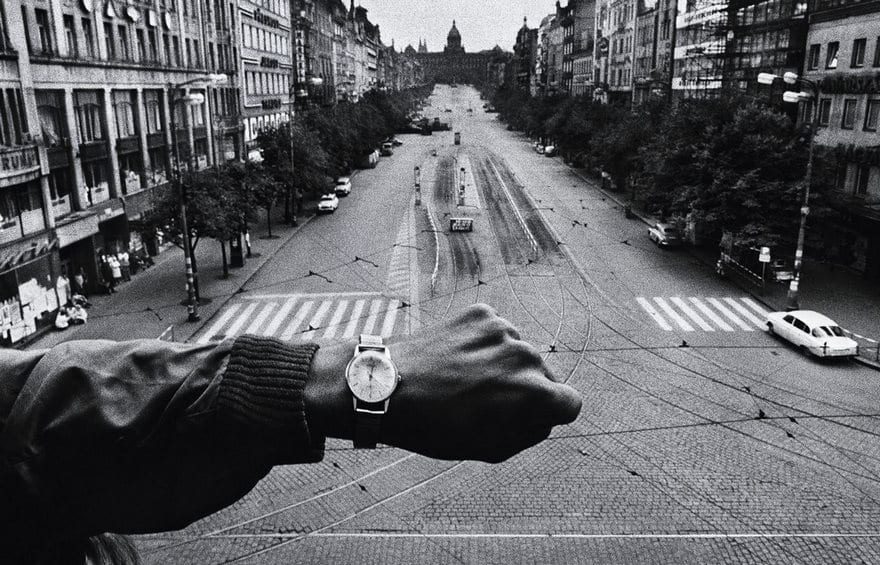Invasion of Prague, Josef Koudelka, 1968
Josef Koudelka, a young Moravian-born engineer who had been taking wistful and gritty photos of Czech life, was in the capital when the soldiers arrived. He took pictures of the swirling turmoil and created a groundbreaking record of the invasion that would change the course of his nation. The most seminal piece includes a man’s arm in the foreground, showing on his wristwatch a moment of the Soviet invasion with a deserted street in the distance. It beautifully encapsulates time, loss and emptiness—and the strangling of a society.
I chose this picture because of the emptiness it gives. It feels like a liminal space picture. It also reminds me of quarantine days during Covid-19. The empty city photos.
The Hindenberg Disaster, Sam Shere, 1937
Zeppelins were majestic skyliners, luxurious behemoths that signified wealth and power. The arrival of these ships was news, which is why Sam Shere of the International News Photos service was waiting in the rain at the Lakehurst, N.J., Naval Air Station on May 6, 1937, for the 804-foot-long LZ 129 Hindenburg to drift in from Frankfurt. Suddenly, as the assembled media watched, the grand ship’s flammable hydrogen caught fire, causing it to spectacularly burst into bright yellow flames and kill 36 people. Shere was one of nearly two dozen still and newsreel photographers who scrambled to document the fast-moving tragedy. But it is his image, with its stark immediacy and horrible grandeur, that has endured as the most famous—owing to its publication on front pages around the world and in LIFE and, more than three decades later, its use on the cover of the first Led Zeppelin album. The crash helped bring the age of the airships to a close, and Shere’s powerful photograph of one of the world’s most formative early air disasters persists as a cautionary reminder of how human fallibility can lead to death and destruction.
I instantly recognized this one by its appearance as Led Zeppelin’s first album’s cover. I also like the story as well behind the picture and wonder if zeppelins can ever come back as a luxury.
Pillars of Creation, Nasa, 1995
The Hubble Space Telescope almost didn’t make it. Carried aloft in 1990 aboard the space shuttle Atlantis, it was over-budget, years behind schedule and, when it finally reached orbit, nearsighted, its 8-foot mirror distorted as a result of a manufacturing flaw. It would not be until 1993 that a repair mission would bring Hubble online. Finally, on April 1, 1995, the telescope delivered the goods, capturing an image of the universe so clear and deep that it has come to be known as Pillars of Creation. What Hubble photographed is the Eagle Nebula, a star-forming patch of space 6,500 light-years from Earth in the constellation Serpens Cauda. The great smokestacks are vast clouds of interstellar dust, shaped by the high-energy winds blowing out from nearby stars (the black portion in the top right is from the magnification of one of Hubble’s four cameras). But the science of the pillars has been the lesser part of their significance. Both the oddness and the enormousness of the formation—the pillars are 5 light-years, or 30 trillion miles, long—awed, thrilled and humbled in equal measure. One image achieved what a thousand astronomy symposia never could.
I chose the picture because of the beautiful colors present. To me, the pillars look like humanoid creatures standing in space.


